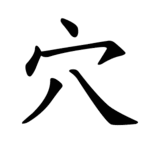| 穴 | ||
|---|---|---|
| ||
| 穴 (U+7A74) "cave" | ||
| Pronunciations | ||
| Pinyin: | xué | |
| Bopomofo: | ㄒㄩㄝˊ | |
| Wade–Giles: | hsüeh2 | |
| Cantonese Yale: | yut6 | |
| Jyutping: | jyut6 | |
| Japanese Kana: | ケツ ketsu (on'yomi) あな ana (kun'yomi) | |
| Sino-Korean: | 혈 hyeol | |
| Names | ||
| Chinese name(s): | 穴寶蓋/穴宝盖 xuébǎogài 穴字頭/穴字头 xuézìtóu | |
| Japanese name(s): | 穴/あな ana 穴冠/あなかんむり anakanmuri | |
| Hangul: | 구멍 gumeong | |
| Stroke order animation | ||
 | ||
Radical 116 or radical cave (穴部) meaning "cave" is one of the 23 Kangxi radicals (214 radicals in total) composed of 5 strokes.
In the Kangxi Dictionary, there are 298 characters (out of 49,030) to be found under this radical.
穴 is also the 117th indexing component in the Table of Indexing Chinese Character Components predominantly adopted by Simplified Chinese dictionaries published in mainland China.
Evolution
 Large seal script character
Large seal script character Small seal script character
Small seal script character
Derived characters
| Strokes | Characters |
|---|---|
| +0 | 穴 |
| +1 | 穵 |
| +2 | 究 穷SC (=窮) |
| +3 | 穸 穹 空 穻 |
| +4 | 穼 穽 (=阱 -> 阜) 穾 穿 窀 突 窂 (=牢 -> 牛) 窃SC (=竊) |
| +5 | 窄 窅 窆 窇 窈 窉 窊 窋 窌 窍SC (=竅) 窎SC (=窵) |
| +6 | 窏 窐 窑SC (=窯) 窒 窓JP (=窗) 窔 窕 |
| +7 | 窖 窗 窘 窙 窚 窛 窜SC (=竄) 窝SC (=窩) |
| +8 | 窞 窟 窠 窡 窢 窣 窤 窥SC (=窺) 窦SC (=竇) 窧 |
| +9 | 窨 窩 窪 窫 窬 窭SC (=窶) |
| +10 | 窮 窯 窰 (=窯) 窱 窲 窳 窴 |
| +11 | 窵 窶 窷 窸 窹 窺 窻 (=窗) 窼 窽 |
| +12 | 窾 窿 竀 竁 竂 (=寮 -> 宀) 竃 (=灶 -> 火) |
| +13 | 竄 竅 |
| +14 | 竆 (=窮) |
| +15 | 竇 |
| +16 | 竈 (=灶 -> 火) 竉 |
| +17 | 竊 |
Variant forms
This radical character takes different forms in different languages. In the Kangxi Dictionary, the first stroke is a vertical dot, and the last stroke of the radical character starts with a short horizontal line when appearing independently (穴), and becomes a vertical-curve-horizontal stroke ㇄ when used as an upper component, with an exception of 空 in which the radical's last stroke starts with a short horizontal line (穴+工). In Japanese and Korean hanja, when used as an upper component, the last stroke of the radical character is a vertical-curve-hook stroke ㇟. In Traditional Chinese used in Taiwan and Hong Kong, its last stroke is a vertical-curve-horizontal stroke ㇄. In Mainland China's xin zixing, it is a rightward dot.
| Traditional Chinese | Simplified Chinese | Japanese | Korean |
|---|---|---|---|
| 穴 空 | 穴 空 | 穴 空 | 穴 空 |
Sinogram
The radical is also used as an independent Chinese character. It is one of the Kyōiku kanji or Kanji taught in elementary school in Japan.[1] It is a fifth grade kanji.[1]
References
- 1 2 "The Kyoiku Kanji (教育漢字) - Kanshudo". www.kanshudo.com. Archived from the original on March 24, 2022. Retrieved 2023-05-06.
Literature
- Fazzioli, Edoardo (1987). Chinese calligraphy : from pictograph to ideogram : the history of 214 essential Chinese/Japanese characters. calligraphy by Rebecca Hon Ko. New York: Abbeville Press. ISBN 0-89659-774-1.
- Lunde, Ken (Jan 5, 2009). "Appendix J: Japanese Character Sets" (PDF). CJKV Information Processing: Chinese, Japanese, Korean & Vietnamese Computing (Second ed.). Sebastopol, Calif.: O'Reilly Media. ISBN 978-0-596-51447-1.